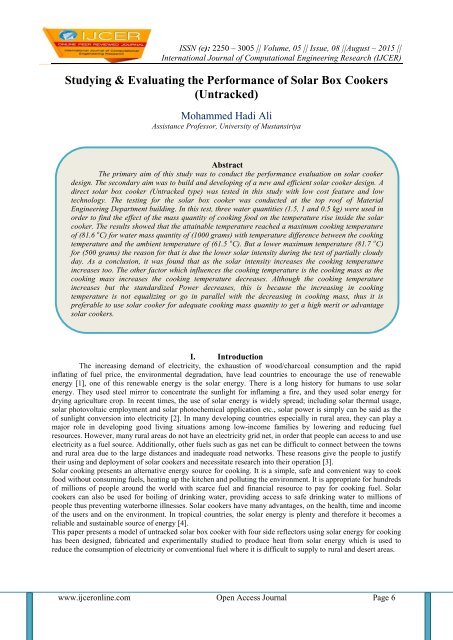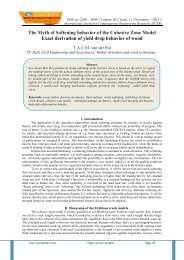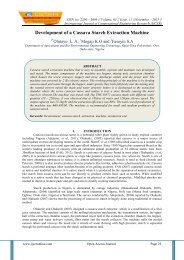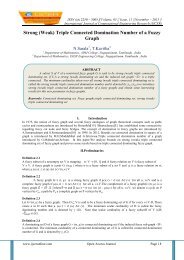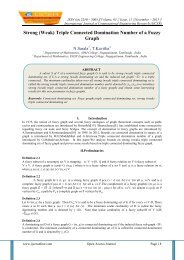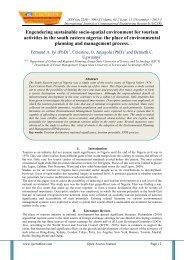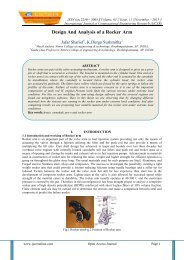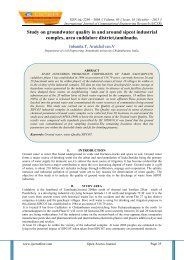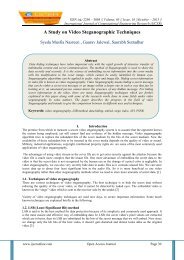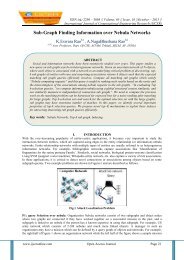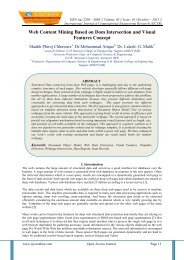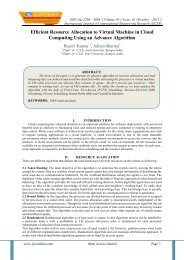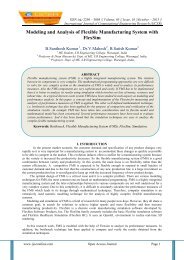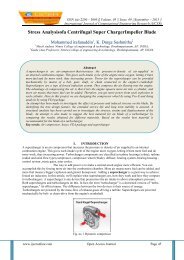Studying & Evaluating the Performance of Solar Box Cookers (Untracked)
- No tags were found...
Create successful ePaper yourself
Turn your PDF publications into a flip-book with our unique Google optimized e-Paper software.
ISSN (e): 2250 – 3005 || Volume, 05 || Issue, 08 ||August – 2015 ||<br />
International Journal <strong>of</strong> Computational Engineering Research (IJCER)<br />
<strong>Studying</strong> & <strong>Evaluating</strong> <strong>the</strong> <strong>Performance</strong> <strong>of</strong> <strong>Solar</strong> <strong>Box</strong> <strong>Cookers</strong><br />
(<strong>Untracked</strong>)<br />
Mohammed Hadi Ali<br />
Assistance Pr<strong>of</strong>essor, University <strong>of</strong> Mustansiriya<br />
Abstract<br />
The primary aim <strong>of</strong> this study was to conduct <strong>the</strong> performance evaluation on solar cooker<br />
design. The secondary aim was to build and developing <strong>of</strong> a new and efficient solar cooker design. A<br />
direct solar box cooker (<strong>Untracked</strong> type) was tested in this study with low cost feature and low<br />
technology. The testing for <strong>the</strong> solar box cooker was conducted at <strong>the</strong> top ro<strong>of</strong> <strong>of</strong> Material<br />
Engineering Department building. In this test, three water quantities (1.5, 1 and 0.5 kg) were used in<br />
order to find <strong>the</strong> effect <strong>of</strong> <strong>the</strong> mass quantity <strong>of</strong> cooking food on <strong>the</strong> temperature rise inside <strong>the</strong> solar<br />
cooker. The results showed that <strong>the</strong> attainable temperature reached a maximum cooking temperature<br />
<strong>of</strong> (81.6 o C) for water mass quantity <strong>of</strong> (1000 grams) with temperature difference between <strong>the</strong> cooking<br />
temperature and <strong>the</strong> ambient temperature <strong>of</strong> (61.5 o C). But a lower maximum temperature (81.7 o C)<br />
for (500 grams) <strong>the</strong> reason for that is due <strong>the</strong> lower solar intensity during <strong>the</strong> test <strong>of</strong> partially cloudy<br />
day. As a conclusion, it was found that as <strong>the</strong> solar intensity increases <strong>the</strong> cooking temperature<br />
increases too. The o<strong>the</strong>r factor which influences <strong>the</strong> cooking temperature is <strong>the</strong> cooking mass as <strong>the</strong><br />
cooking mass increases <strong>the</strong> cooking temperature decreases. Although <strong>the</strong> cooking temperature<br />
increases but <strong>the</strong> standardized Power decreases, this is because <strong>the</strong> increasing in cooking<br />
temperature is not equalizing or go in parallel with <strong>the</strong> decreasing in cooking mass, thus it is<br />
preferable to use solar cooker for adequate cooking mass quantity to get a high merit or advantage<br />
solar cookers.<br />
I. Introduction<br />
The increasing demand <strong>of</strong> electricity, <strong>the</strong> exhaustion <strong>of</strong> wood/charcoal consumption and <strong>the</strong> rapid<br />
inflating <strong>of</strong> fuel price, <strong>the</strong> environmental degradation, have lead countries to encourage <strong>the</strong> use <strong>of</strong> renewable<br />
energy [1], one <strong>of</strong> this renewable energy is <strong>the</strong> solar energy. There is a long history for humans to use solar<br />
energy. They used steel mirror to concentrate <strong>the</strong> sunlight for inflaming a fire, and <strong>the</strong>y used solar energy for<br />
drying agriculture crop. In recent times, <strong>the</strong> use <strong>of</strong> solar energy is widely spread; including solar <strong>the</strong>rmal usage,<br />
solar photovoltaic employment and solar photochemical application etc., solar power is simply can be said as <strong>the</strong><br />
<strong>of</strong> sunlight conversion into electricity [2]. In many developing countries especially in rural area, <strong>the</strong>y can play a<br />
major role in developing good living situations among low-income families by lowering and reducing fuel<br />
resources. However, many rural areas do not have an electricity grid net, in order that people can access to and use<br />
electricity as a fuel source. Additionally, o<strong>the</strong>r fuels such as gas net can be difficult to connect between <strong>the</strong> towns<br />
and rural area due to <strong>the</strong> large distances and inadequate road networks. These reasons give <strong>the</strong> people to justify<br />
<strong>the</strong>ir using and deployment <strong>of</strong> solar cookers and necessitate research into <strong>the</strong>ir operation [3].<br />
<strong>Solar</strong> cooking presents an alternative energy source for cooking. It is a simple, safe and convenient way to cook<br />
food without consuming fuels, heating up <strong>the</strong> kitchen and polluting <strong>the</strong> environment. It is appropriate for hundreds<br />
<strong>of</strong> millions <strong>of</strong> people around <strong>the</strong> world with scarce fuel and financial resource to pay for cooking fuel. <strong>Solar</strong><br />
cookers can also be used for boiling <strong>of</strong> drinking water, providing access to safe drinking water to millions <strong>of</strong><br />
people thus preventing waterborne illnesses. <strong>Solar</strong> cookers have many advantages, on <strong>the</strong> health, time and income<br />
<strong>of</strong> <strong>the</strong> users and on <strong>the</strong> environment. In tropical countries, <strong>the</strong> solar energy is plenty and <strong>the</strong>refore it becomes a<br />
reliable and sustainable source <strong>of</strong> energy [4].<br />
This paper presents a model <strong>of</strong> untracked solar box cooker with four side reflectors using solar energy for cooking<br />
has been designed, fabricated and experimentally studied to produce heat from solar energy which is used to<br />
reduce <strong>the</strong> consumption <strong>of</strong> electricity or conventional fuel where it is difficult to supply to rural and desert areas.<br />
www.ijceronline.com Open Access Journal Page 6
<strong>Studying</strong> & <strong>Evaluating</strong> <strong>the</strong> <strong>Performance</strong> <strong>of</strong> <strong>Solar</strong>…<br />
II. The Research Goal<br />
The goal <strong>of</strong> this paper is to carry out a design, fabrication, investigation and testing <strong>the</strong> model <strong>of</strong> an<br />
untracked solar box cooker prepared for this study to obtain <strong>the</strong> <strong>the</strong>rmal performance for such type and taking into<br />
account all <strong>the</strong> points to gain heat and reducing <strong>the</strong> heat losses.<br />
III. Experimental Rig Description<br />
The solar cooker model is made mainly <strong>of</strong> plywood with an overall dimensions (40 cm X 40 cm X 40 cm), it<br />
consist <strong>of</strong> <strong>the</strong> following parts [figure (1)]:<br />
Figure ( 1 ): <strong>the</strong> solar box cooker with four sides reflectors prototype.<br />
1. The aperture window <strong>of</strong> [40 cm X 40 cm] made <strong>of</strong> glass cover (6 mm thickness) which is supported by<br />
cooker sides' structure, <strong>the</strong> purpose <strong>of</strong> <strong>the</strong> glass cover is to close <strong>the</strong> solar box and help to capture and<br />
trap <strong>the</strong> solar heat inside <strong>the</strong> solar box.<br />
2. A dark absorber plate exposed to solar radiation aligned horizontally inside <strong>the</strong> cooker chamber is made<br />
<strong>of</strong> a thick aluminum plate <strong>of</strong> (3 mm) thickness, to highly absorbing <strong>the</strong> solar heat incident on it.<br />
3. The four reflectors [trapezoidal shape <strong>of</strong> lower base <strong>of</strong> (40 cm), upper base <strong>of</strong> (80cm) and height <strong>of</strong> (40<br />
cm)] were covered with mirrors which are well stuck to reflectors using special glue. The reflector angles<br />
for <strong>the</strong> solar cooker were tilted with (30 0 ) with <strong>the</strong> vertical showing <strong>the</strong> best amount <strong>of</strong> admitted sunlight<br />
can captured into solar cooker [5]. The mirrors were used to reflect and direct <strong>the</strong> solar rays into <strong>the</strong> solar<br />
oven through <strong>the</strong> glass cover.<br />
4. The cooker sides and its bottom were insulated with a Polystyrene board <strong>of</strong> (50 mm) thickness. This will<br />
help to reduce <strong>the</strong> heat dissipated outside <strong>the</strong> cooker and to improve its performance, <strong>the</strong> only side to loss<br />
heat form <strong>the</strong> solar cooker is from <strong>the</strong> glass cover which is exposed to <strong>the</strong> sky.<br />
5. The solar cooker was oriented according to Baghdad latitude which is (33.4 o degree) in <strong>the</strong> nor<strong>the</strong>rn<br />
sector <strong>of</strong> earth. The tilt angle was calculated for Baghdad city to be found equal to (29 o degree) by using<br />
<strong>the</strong> following formula [6] for latitude between (25 o to 50 o ):<br />
6. A pot with cover made <strong>of</strong> aluminum is used to warm (cooking) water inside it. The pot is painted with<br />
black color in order to highly absorbing <strong>the</strong> solar heat incident on it, it will get warm faster.<br />
7. The measuring instruments used in this experiment include <strong>the</strong> digital <strong>the</strong>rmometer instrument and digital<br />
solar intensity instrument:<br />
www.ijceronline.com Open Access Journal Page 7
<strong>Studying</strong> & <strong>Evaluating</strong> <strong>the</strong> <strong>Performance</strong> <strong>of</strong> <strong>Solar</strong>…<br />
Two digital <strong>the</strong>rmometers model (TM – 924C) each <strong>of</strong> two channels <strong>the</strong>rmocouple are connected in<br />
order to measure temperature in four positions:<br />
T 1 : is <strong>the</strong> ambient temperature outside <strong>the</strong> solar cooker (°C) .<br />
T 2 : is <strong>the</strong> temperature <strong>of</strong> <strong>the</strong> absorber plate (°C).<br />
T 3 : is <strong>the</strong> temperature <strong>of</strong> <strong>the</strong> cooking water inside <strong>the</strong> pot (°C).<br />
T 4 : is <strong>the</strong> temperature inside solar cooker chamber (°C).<br />
For measuring <strong>the</strong>se four temperatures, it was used a special <strong>the</strong>rmocouple type (K) in which it is connected to <strong>the</strong><br />
dual <strong>the</strong>rmometer instrument.<br />
<br />
<br />
The digital solar radiation instrument is used to measure <strong>the</strong> horizontal solar intensity [model solar<br />
power measuring instrument type (SPM – 1116 SD), which is applicable to measure <strong>the</strong> solar<br />
radiation and solar power.<br />
The wind speed ( V ) was determined using <strong>the</strong> digital Thermo – Anemometer (model: AM-4210E).<br />
IV. Theoretical Analysis<br />
In this paragraph, and in order to determine <strong>the</strong> performance <strong>of</strong> <strong>the</strong> solar cooker prototype, <strong>the</strong> standard<br />
which was originally developed by Dr. Paul Funk as an international testing standard for solar cookers was used.<br />
This standard was recognized at <strong>the</strong> Third World Conference on <strong>Solar</strong> Cooking, in January <strong>of</strong> 1997 (Funk, 2000).<br />
The goal <strong>of</strong> this standard was to produce a simple, yet meaningful and objective measure <strong>of</strong> cooker performance<br />
that was not so complicated as to make testing in less developed areas prohibitive.<br />
Temperature measurements are made <strong>of</strong> <strong>the</strong> water and averaged over 10 minute intervals. Ambient temperature<br />
and normal irradiance (solar energy flux per area) are also measured and recorded. This is calculated through <strong>the</strong><br />
following procedure [7]:<br />
Where:<br />
P = cooking power (W)<br />
T 2 = final water temperature ( o C)<br />
T 1 = initial water temperature ( o C)<br />
m = mass <strong>of</strong> water (kg)<br />
C p = heat capacity (4168 J/kg. K)<br />
Equation (1) was divided by (600 sec.) <strong>of</strong> each (10 minute) to get <strong>the</strong> power produced by <strong>the</strong> solar cooker in each<br />
(10 minute).<br />
To determine <strong>the</strong> standardized cooking power (P s ), (P) is multiplied by <strong>the</strong> standard and normalized solar<br />
irradiance figure <strong>of</strong> (700 W/m 2 ) and divided by <strong>the</strong> average global irradiance <strong>of</strong> that interval through <strong>the</strong> following<br />
equation:<br />
Where:<br />
P = cooking power (W)<br />
P s = <strong>the</strong> standardized cooking power (W)<br />
I = interval average insolation (W/m 2 )<br />
Tests were performed to study and evaluate <strong>the</strong> performance for <strong>Solar</strong> <strong>Cookers</strong> (Un-Tracked) and Reporting<br />
<strong>Performance</strong> according to (Funk, 1997), with and under <strong>the</strong> following conditions [8]:<br />
• Testing was carried out between 9:00 and 14:00 solar time.<br />
• Ambient temperature and wind speed were recorded (it is less than 2.5 m/s).<br />
• The test began with water at ambient temperature. Cooking temperature was recorded.<br />
• The horizontal irradiance were recorded and averaged for a 10- minute interval.<br />
• Wind speeds greater than (2.5 m/s) and ambient temperatures below (20 ºC) were disregarded.<br />
V. Results and Discussion<br />
In this paragraph, <strong>the</strong> analysis for this research shows <strong>the</strong> possibility to evaluate <strong>the</strong> solar cooker<br />
performance by using three different quantities <strong>of</strong> water as a cooking food. Those quantities are (1.5 kg, 1 kg and<br />
0.5 kg); in this way <strong>the</strong> standardized cooking power (P s ) can be predicted and used as a factor <strong>of</strong> merit to show <strong>the</strong><br />
solar cooker performance.<br />
The testing was carried out at three successive days from (19 to 21April). The measured temperatures for <strong>the</strong><br />
water mass for (1.5 kg), <strong>the</strong> absorber plate, <strong>the</strong> solar cooker chamber temperature and <strong>the</strong> ambient temperature,<br />
www.ijceronline.com Open Access Journal Page 8
<strong>Studying</strong> & <strong>Evaluating</strong> <strong>the</strong> <strong>Performance</strong> <strong>of</strong> <strong>Solar</strong>…<br />
Figure (2) showing <strong>the</strong> temperatures variation with solar time conducted between (9:00 morning and 14:00<br />
afternoon).<br />
Figure (2): The temperatures variation for (1.5 kg) water mass.<br />
The water cooking temperature is risen at <strong>the</strong> beginning <strong>of</strong> heating to a maximum temperature <strong>of</strong> (76.6 o C) at solar<br />
time <strong>of</strong> (1:30 afternoon) and start to fall down, while <strong>the</strong> absorber plate temperature reaches its maximum<br />
temperature <strong>of</strong> (88.6 o C) at (1:00 afternoon) and <strong>the</strong> solar cooker's chamber temperature has its maximum<br />
temperature <strong>of</strong> (77.2 o C) at (1:00 afternoon). The maximum temperature difference between <strong>the</strong> water cooking<br />
temperature and <strong>the</strong> initial water temperature is at (1:30 afternoon) is (56.7 o C).<br />
In <strong>the</strong> same manner, figure (3) showing <strong>the</strong> temperatures variation with solar time conducted between (9:00<br />
morning and 14:00 afternoon) for water mass <strong>of</strong> (1 kg). The maximum water cooking temperature <strong>of</strong> (82.3 o C) at<br />
solar time <strong>of</strong> (1:30 afternoon) was obtained, while <strong>the</strong> absorber plate temperature reaches its maximum<br />
temperature <strong>of</strong> (96.1 o C) at (12:00 afternoon) and <strong>the</strong> solar cooker's ambient temperature has its maximum<br />
temperature <strong>of</strong> (84 o C) at (12:00 afternoon). The maximum temperature difference between <strong>the</strong> water cooking<br />
temperature and ambient temperature is at (1:30 afternoon) is (62.2 o C).<br />
Figure (3): The temperatures variation for (1 kg) water mass.<br />
In <strong>the</strong> same manner, figure (4) showing <strong>the</strong> temperatures variation with solar time conducted between (9:00<br />
morning and 14:00 afternoon) for water mass <strong>of</strong> (0.5 kg). The maximum water cooking temperature <strong>of</strong> (83 o C) at<br />
solar time <strong>of</strong> (1:30 afternoon) was obtained, while <strong>the</strong> absorber plate temperature reaches its maximum<br />
temperature <strong>of</strong> (93.2 o C) at (12:30 afternoon) and <strong>the</strong> solar cooker's ambient temperature has its maximum<br />
temperature <strong>of</strong> (82.3 o C) at (12:30 afternoon).<br />
Figure (4): The temperatures variation for (0.5 kg) water mass.<br />
The maximum temperature difference between <strong>the</strong> water cooking temperature and ambient temperature is at (1:30<br />
afternoon) is (62.5 o C).<br />
www.ijceronline.com Open Access Journal Page 9
<strong>Studying</strong> & <strong>Evaluating</strong> <strong>the</strong> <strong>Performance</strong> <strong>of</strong> <strong>Solar</strong>…<br />
Figures ( 5, 6 and 7) showing <strong>the</strong> water cooking temperatures and solar intensity falling on <strong>the</strong> solar cooker<br />
against solar time. It was noticed that at <strong>the</strong> beginning <strong>the</strong> water cooking temperature increases due <strong>the</strong> solar heat<br />
accumulated inside <strong>the</strong> solar oven and trapped inside <strong>the</strong> solar oven, <strong>the</strong>n it will begin to fall down as <strong>the</strong> solar<br />
radiation intensity decreases at solar time <strong>of</strong> (12:00 noon).<br />
The highest water cooking temperature that is being obtained is (83.2 o C) for water mass quantity <strong>of</strong> (0.5 kg) on<br />
(21 st <strong>of</strong> April) which a dusty day (not clear and shine), it could be reached to higher temperature but it can be<br />
concluded from <strong>the</strong> figure (7) that <strong>the</strong> solar intensity less than <strong>the</strong> o<strong>the</strong>r measuring days (19 th and 20 th <strong>of</strong> April) as<br />
a result less average total solar radiation incident on <strong>the</strong> solar oven and thus a lower maximum water cooking<br />
temperature was obtained.<br />
Figure (5): The cooking temperature for (1.5 kg) water mass versus solar radiation intensity for (19 th <strong>of</strong><br />
April).<br />
Figure (6): The cooking temperature for (1 kg) water mass versus solar radiation intensity for (20 th <strong>of</strong><br />
April).<br />
Figure (7): The cooking temperature for (0.5 kg) water mass versus solar radiation intensity for (21 st <strong>of</strong><br />
April).<br />
As a conclusion, <strong>the</strong> cooking temperature increases as <strong>the</strong> average solar radiation intensity increases and vice<br />
versa during <strong>the</strong> conducted solar time interval that will be used for cooking.<br />
Ano<strong>the</strong>r point that affects <strong>the</strong> temperature rise <strong>of</strong> cooking water is <strong>the</strong> mass quantity which is used in cooking, and<br />
as <strong>the</strong> mass quantity which is used in cooking increases yielding to a lower cooking temperature.<br />
Figures ( 8, 9 and 10) showing <strong>the</strong> performance <strong>of</strong> <strong>the</strong> solar box cooker (Standardized Cooking Power) which has<br />
been established versus <strong>the</strong> temperature differences. It was noticed that <strong>the</strong> performance for solar box cooker<br />
increases as <strong>the</strong> temperature difference increases too, but <strong>the</strong> most important point is as <strong>the</strong> water quantity<br />
increases <strong>the</strong> performance for solar box cooker increases too.<br />
www.ijceronline.com Open Access Journal Page 10
<strong>Studying</strong> & <strong>Evaluating</strong> <strong>the</strong> <strong>Performance</strong> <strong>of</strong> <strong>Solar</strong>…<br />
The highest standardized cooking power was obtained for water quantity <strong>of</strong> (1.5 kg) which was reached to about<br />
(650 W), while <strong>the</strong> lowest was obtained for (0.5 kg) which was reached to about (270 W).<br />
This is because <strong>the</strong> increasing in cooking temperature is not equalizing or go in parallel with <strong>the</strong> decreasing in<br />
cooking mass, thus it is preferable to use solar cooker for adequate cooking mass quantity to get a high merit or<br />
advantage solar cookers.<br />
Figures ( 8, 9 and 10) showing too, <strong>the</strong> best linear fitting curve equations for <strong>the</strong> different water quantities and its<br />
coefficient <strong>of</strong> fitness (R 2 ). The coefficients <strong>of</strong> fitness for <strong>the</strong>m is not less than (0.98)<br />
www.ijceronline.com Open Access Journal Page 11
<strong>Studying</strong> & <strong>Evaluating</strong> <strong>the</strong> <strong>Performance</strong> <strong>of</strong> <strong>Solar</strong>…<br />
References<br />
[1] Chaouki Ali, et. al., 2010, "Theoretical Study and Design <strong>of</strong> a Hybrid <strong>Solar</strong> Cooker", IJRRAS, Volume (3), Issue (3), 2010.<br />
[2] A. Claude et al., 2012, "Engineering, design and fabrication <strong>of</strong> a solar cooker with parabolic concentrator for heating, drying and<br />
cooking purposes", Archives <strong>of</strong> Applied Science Research, Vol. (4), Issue (4), 2012.<br />
[3] R.Gayapershad, S.T. Dladla and M.J. Brooks, "Preliminary Results from a <strong>Performance</strong> Evaluation Study <strong>of</strong> Commercial <strong>Solar</strong><br />
<strong>Cookers</strong>", http://www.wcpsd.org/posters/environment/Gayapershad.pdf<br />
[4] C Z M Kimambo, 2007, "Development and performance testing <strong>of</strong> solar cookers", Journal <strong>of</strong> Energy in Sou<strong>the</strong>rn Africa • Vol 18<br />
No 3 • August 2007.<br />
[5] Dean Still and Jim Kness, "Heat Capturing, Five Earth-Friendly Cooking Technologies & How to Build Them", Aprovecho<br />
Research Center, Mexico.<br />
[6] Charles R. Landau, "Optimum Tilt <strong>of</strong> <strong>Solar</strong> Panels", 2014, http://www.solarpaneltilt.com/[10/31/2014 10:38:53 PM]<br />
[7] Shawn Shaw, "Development <strong>of</strong> a Comparative Framework for <strong>Evaluating</strong> <strong>the</strong> <strong>Performance</strong> <strong>of</strong> <strong>Solar</strong> Cooking Devices",<br />
http://images3.wikia.nocookie.net/__cb20080215190132/solarcooking/images/e/e5/Shawn_Shaw_<strong>the</strong>sis_on_solar_cooker_testing_<br />
standards.pdf<br />
[8] R.Gayapershad, S.T. Dladla and M.J. Brooks, " Preliminary Results from a <strong>Performance</strong> Evaluation Study <strong>of</strong> Commercial <strong>Solar</strong><br />
<strong>Cookers</strong>", http://www.wcpsd.org/posters/environment/Gayapershad.pdf<br />
www.ijceronline.com Open Access Journal Page 12


